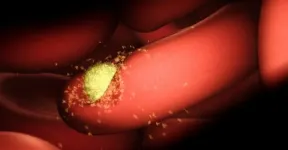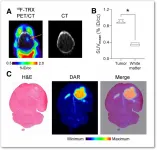(Press-News.org) SAN FRANCISCO, CA--July 22, 2021--To speed up a chemical reaction, a chemist might place the reactants over a Bunsen burner. Adding heat increases the degree of random movements and collisions of particles, accelerating the reaction.
In cell biology, one important "reaction" is the transformation of stem cells into all the other cells in the body, a process known as differentiation. Gladstone Institutes researchers have now discovered a molecular mechanism that acts like a Bunsen burner to "turn up the heat" and accelerate differentiation.
However, instead of boosting temperature, this process amplifies random fluctuations in levels of gene expression--or which genes are turned on or off within a cell. Boosting these fluctuations, also known as "noise," appears to aid the switch from one cell type to another.
"Researchers have studied and characterized these fluctuations, or 'noise' in gene expression, for decades," says Leor Weinberger, PhD, William and Ute Bowes Distinguished Professor, and director of the Center for Cell Circuitry at Gladstone. "But it was unclear if this noise was simply an unavoidable by-product of gene expression, which was widely assumed, or if it played some functional role."
Now, as reported in the journal Science, he and his team have discovered a pathway they named discordant transcription through repair (DiThR, pronounced "dither"). The DiThR pathway appears to boost the noisiness of gene expression in stem cells and enhance their ability to differentiate.
A New Fundamental Mechanism
The discovery of the DiThR pathway arose from the team's earlier work on HIV.
"We'd been tackling a long-standing problem in HIV, namely how to alter HIV's ability to persist in a long-lived latent state in patients," says Weinberger, who is also a professor of biochemistry and biophysics, and pharmaceutical chemistry at UC San Francisco (UCSF). "We discovered that molecules that alter viral expression noise also reduced HIV persistence."
"It was pretty startling when these same molecules worked in stem cells," he adds. "And, trying to understand how these molecules work turned into a search for a fundamental biological mechanism."
When a gene is turned on, or expressed, the information stored in the gene is used to build substances that a cell needs to function. But the vast majority of genes do not stay on all the time.
Most genes toggle--or switch between active and inactive states, turning on and off--every few minutes to every few hours. This creates noise in gene-expression levels. HIV, once it infects a cell, acts very much like a human gene and exhibits similar noise properties.
While studying HIV, Weinberger's team uncovered the existence of molecules that could enhance noise, or switch the expression machinery between active and inactive states, but, curiously, without affecting the average level of expression. They called them noise-enhancer molecules. These molecules acted like Bunsen burners for gene expression and increased the efficiency of drugs designed to wake HIV from a silent state, which is part of a strategy to cure patients.
But how these noise-enhancer molecules could boost noise without altering expression levels was completely unknown.
On a whim, the scientists examined what happened when noise-enhancer molecules were applied to embryonic stem cells without HIV. Amazingly, these molecules had the same effect on stem cells as they did on HIV, amplifying noise without changing the expression level. They also accelerated the stem cells' ability to transform into other cell types.
The team's main findings were that the mechanism by which noise-enhancer molecules boost noise involves a process for repairing certain errors in DNA that may arise when genes are turned on. A key component of this DNA repair process is a protein known as AP endonuclease 1 (Apex1).
"We found that Apex1 directly alters the shape of the DNA double helix in a way that first impedes and then accelerates gene expression," says the study's first author, Ravi Desai, an MD/PhD student in the UCSF Medical Scientist Training program in Weinberger's lab.
The team showed that Apex1 is the critical factor in this new DiThR pathway, which increases noise across the entire array of genes in the genome.
Making Differentiation More Efficient
Next, because some noise-enhancer molecules are found naturally in stem cells, the team asked how the newly discovered mechanism might affect the transformation of stem cells into other cell types. They treated mouse embryonic stem cells with both noise-enhancer molecules and substances that prompt differentiation into other types of cells.
They found that the increased noise imparted by DiThR allowed the stem cells to differentiate more efficiently, like the Bunsen burner does for chemical reactions.
What's more, the mechanism also worked in the opposite direction. It improved the efficiency of a process that turns differentiated cells back into pluripotent stem cells, which have the potential to become several different cell types--a finding that earned Gladstone scientist Shinya Yamanaka, MD, PhD, a Nobel Prize in 2012.
"Our findings suggest that the DiThR pathway makes cells more responsive to the signals that guide their fate," says Desai. "That means this mechanism may play a fundamental biological role in the development of embryos."
Looking ahead, the research team plans to further map out the various components of the DiThR pathway.
"Our goal now is to understand how DiThR is regulated and if associated noise-control pathways exist," Weinberger says. "Ultimately, approaches to harness these pathways could dramatically improve cellular engineering and stem cell-based therapies."
INFORMATION:
About the Study
The paper "A DNA-Repair Pathway Controls Transcriptional Noise to Promote Cell-Fate 1 Transitions" was published by the journal Science on July 22, 2021: https://science.sciencemag.org/content/early/2021/07/21/science.abc6506
Other authors include Xinyue Chen, Benjamin Martin, Sonali Chaturvedi, Chen Yu, and Sheng Ding of Gladstone Institutes; Dong Woo Hwang, Weihan Li, Robert Singer, and Robert Coleman of Albert Einstein College of Medicine; Matt Thomson of California Institute of Technology; and Maike Hansen of Radboud University.
The work at Gladstone was funded by the National Institutes of Health (NIH) (HD095614-03, 1R01GM126045-05, R01AI109593), the Bowes Distinguished Professorship, the Alfred P. Sloan Foundation, the Pew Scholars Program in the Biomedical Sciences, as well as the NIH Director's New Innovator Award (OD006677) and Pioneer Award (OD17181) programs.
About Gladstone Institutes
To ensure our work does the greatest good, Gladstone Institutes (https://www.gladstone.org) focuses on conditions with profound medical, economic, and social impact--unsolved diseases. Gladstone is an independent, nonprofit life science research organization that uses visionary science and technology to overcome disease. It has an academic affiliation with the University of California, San Francisco.
New York, NY (July 23, 2021) -- Mount Sinai researchers have developed a therapeutic agent that shows high effectiveness in vitro at disrupting a biological pathway that helps cancer survive, according to a paper published in Cancer Discovery, a journal of the American Association for Cancer Research, in July.
The therapy is an engineered molecule, named MS21, that causes the degradation of AKT, an enzyme that is overly active in many cancers. This study laid out evidence that pharmacological degradation of AKT is a viable treatment for cancers with mutations in certain genes.
AKT is a cancer gene that encodes an enzyme that is frequently abnormally activated in cancer cells to stimulate tumor growth. Degradation of ...
Advanced technologies have been used to solve a long-standing mystery about why some people develop serious illness when they are infected with the malaria parasite, while others carry the infection asymptomatically.
An international team used mass cytometry - an in-depth way of characterising individual cells - and machine learning to discover 'immune signatures' associated with symptomatic or asymptomatic infections in people infected with the Plasmodium vivax parasite. This uncovered an unexpected role for immune T cells in protection against malaria, ...
How does a view of nature gain its gloss of beauty? We know that the sight of beautiful landscapes engages the brain's reward systems. But how does the brain transform visual signals into aesthetic ones? Why do we perceive a mountain vista or passing clouds as beautiful? A research team from the Max Planck Institute for Empirical Aesthetics has taken up this question and investigated how our brains proceed from merely seeing a landscape to feeling its aesthetic impact.
In their study, the research team presented artistic landscape videos to 24 participants. Using functional magnetic resonance imaging (fMRI), they measured the participants' brain activity as they viewed and rated the videos. Their findings have just been published in the ...
As Xi'an Jiaotong-Liverpool University researchers completed their research on coloured architectural concrete, they found a surprising result--green pigmented cement had impurities that produced porous, poor quality concrete. Meanwhile, red and blue pigments had little effect.
The research was conducted by Mehreen Heerah, a graduate of XJTLU's Department of Civil Engineering, Dr Graham Dawson of XJTLU's Department of Chemistry, and Isaac Galobardes of Mohammed VI Polytechnic University.
Pigmented architectural concrete is used as a visually appealing alternative to grey concrete, such as in Barcelona's Ciutat de la Justícia, explains Dr Dawson. As the demand for pigmented architectural concrete grows, so does the importance of this research.
Not easy ...
New research from the University of Otago debunks a long-held belief about our ancestors' eating habits.
For more than 60 years, researchers have believed Paranthropus, a close fossil relative of ours which lived about one to three million years ago, evolved massive back teeth to consume hard food items such as seeds and nuts, while our own direct ancestors, the genus Homo, is thought to have evolved smaller teeth due to eating softer food such as cooked food and meats.
However, after travelling to several large institutes and museums in South Africa, Japan and the ...
About six gigatons -- roughly 12 times the mass of all living humans -- of carbon appears to be emitted over land every year, according to data from the Chinese Global Carbon Dioxide Monitoring Scientific Experimental Satellite (TanSat).
Using data on how carbon mixes with dry air collected from May 2017 to April 2018, researchers developed the first global carbon flux dataset and map. They published their results in Advances in Atmospheric Sciences.
The map was developed by applying TanSat's satellite observations to models of how greenhouse gasses are exchanged among Earth's atmosphere, land, ...
Reston, VA--A new radiotracer that detects iron in cancer cells has proven effective, opening the door for the advancement of iron-targeted therapies for cancer patients. The radiotracer, 18F-TRX, can be used to measure iron concentration in tumors, which can help predict whether a not the cancer will respond to treatment. This research was published in the July issue of the Journal of Nuclear Medicine.
All cancer cells have an insatiable appetite for iron, which provides them the energy they need to multiply. As a result, tumors have higher levels of iron than normal tissues. Recent advances in chemistry have led scientists to take advantage of this altered state, targeting the expanded cytosolic ...
MUSC Hollings Cancer Center was one of 28 clinical sites around the world that participated in the LOTIS-2 trial to test the efficacy of Loncastuximab tesirine, a promising new treatment for aggressive B-cell lymphoma. The results of the single-arm, phase 2 trial were published online in May 2021 in Lancet Oncology.
Brian Hess, M.D., a Hollings researcher and lymphoma specialist at MUSC Health, was instrumental in bringing the phase 2 trial to Hollings. The manufacturer of Loncastuximab tesirine, ADC Therapeutics S.A., sponsored the trial.
B-cell non-Hodgkin lymphoma (NHL) is a blood cancer that begins in the lymph nodes, spleen or bone marrow. Diffuse large B-cell lymphoma (DLBCL) is the most common subtype of aggressive NHL. New treatment options are vital for patients with DLBCL. ...
Due to the global efforts to meet sustainability standards, many countries are currently looking to replace concrete with wood in buildings. France, for example, will require that all new public buildings will be made from at least 50 percent wood or other sustainable materials starting in 2022.
Because wood is prone to degradation when exposed to sunlight and moisture, protective coatings can help bring wood into wider use. Researchers at Aalto University have used lignin, a natural polymer abundant in wood and other plant sources, to create a safe, low-cost and high-performing coating for use in construction.
'Our new coating has great potential to ...
A new optogenetic tool, a protein that can be controlled by light, has been characterized by researchers at Ruhr-Universität Bochum (RUB). They used an opsin - a protein that occurs in the brain and eyes - from zebrafish and introduced it into the brain of mice. Unlike other optogenetic tools, this opsin is not switched on but rather switched off by light. Experiments also showed that the tool could be suitable for investigating changes in the brain that are responsible for the development of epilepsy.
The teams led by Professor Melanie Mark from the Behavioural Neurobiology Research Group and Professor Stefan Herlitze from the Department ...




